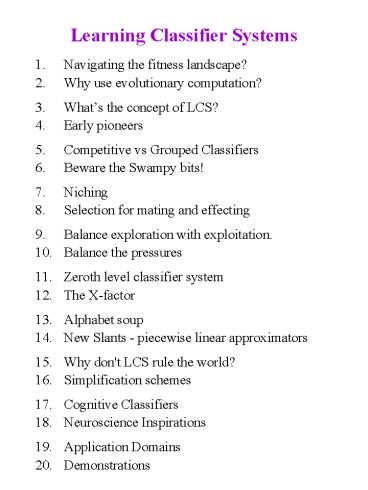Learning Classifier Systems - PowerPoint PPT Presentation
1 / 14
Title:
Learning Classifier Systems
Description:
Standard lcs use hyperrectangles to classify (divide up the input landscape into ... (the most appropriate kernel may not ... Restricted length to control bloat ... – PowerPoint PPT presentation
Number of Views:91
Avg rating:3.0/5.0
Title: Learning Classifier Systems
1
Learning Classifier Systems
- Navigating the fitness landscape?
- Why use evolutionary computation?
- Whats the concept of LCS?
- Early pioneers
- Competitive vs Grouped Classifiers
- Beware the Swampy bits!
- Niching
- Selection for mating and effecting
- Balance exploration with exploitation.
- Balance the pressures
- Zeroth level classifier system
- The X-factor
- Alphabet soup
- New Slants - piecewise linear approximators
- Why don't LCS rule the world?
- Simplification schemes
- Cognitive Classifiers
- Neuroscience Inspirations
- Application Domains
2
Non-piecewise Approximators
- Standard difficulties/restrictions
- Standard lcs use hyperrectangles to classify
(divide up the input landscape into actions) - Oblique data and function approximation cause lcs
difficulty - (the most appropriate kernel may not be a
rectangle) - The action is fixed for each condition range
- (every time classifier matches it has the same
action) - The prediction is eventually stable for each
classifier - (every time a trained classifier matches it has
the same action)
3
Approximators
- Standard difficulties/restrictions
- The complete and accurate map philosophy of XCS
means that actions are finite and discrete - X x ai ? P
- A function from input vectors to scalar payoffs
so the system approximates a separate function
for each action - Problem when action is continuous!
- e.g. Stock market prediction or control of robots
- Standard representations dont function in this
manner - ( note fuzzy logic alphabets can produce
continuous actions, maybe also NNs)
4
XCSF
- Real valued encoding
- Concatenation of interval predicates
- Two-point Crossover crossover point can be
- between predicates
- within an interval predicates
- Mutation
- addition of an amount rand(m0)
- returns value from (0, m0 for lower bound
- Bounded random amount proved better than fixed
amount - Repair used as normal
- Covering lower bound
- Returns value from 0, r0
5
Piecewise CONSTANT Approximators
- Very simple approximators
- Need to approximate the function
- y f(x)
- Let x be the input and y be the payoff
- The closeness of the approximation should be
controllable with the error threshold e0 - When e1 lt e2 evolutionary pressure forces weaker
classifier out of population - No pressure between classifiers with e lt e0
- Efficient distribution of classifiers in a tiling
- Need to minimise overlap as prediction sums
- Wilson, S. W., " Classifiers that approximate
functions" - Natural Computing, 1(2-3), 211-234 (2002).
6
Piecewise CONSTANT Approximators
- 0 to 99 in 20 steps 0 if whole step, o if part
7
Piecewise-Linear Approximators
- Linear approximators
- The action is flexible for each condition range
- (every time classifier matches it has the same
action) - Need to approximate the function
- y f(x)
- With h(x)
- Prediction is linear polynomial of the input
components - Initially approximate a 1-D function
- w1 slope of a straight line
- w0 with its intercept
- Hyperplane approximation to f(x)
8
Piecewise-Linear Approximators
- Linear approximators
- Could adapt weights through evaluation
- (weights concatenated with interval predicates)
- Much simpler to use gradient technique
- t is target, o is output
- Actual - Prediction
- Correction rate usually set to 0.4
9
Piecewise-Linear Approximators
- Correction rate usually set to 0.4
10
Piecewise-Linear Approximators
- Change error threshold, Changes accuracy
e0 10
11
Piecewise-Linear Approximators
- Linear approximators
- Can be multidimensional
- Can restrict actions to aid approximations
- Thus produce generalized classifier
- Exploit
- Explore
- a for each classifier in M
- Special cases
- 101 , P ? 1000a
12
Gene Expressions
- Gene Expression Programming (GEP)
- GEP C. Ferreira 2001
- Similar to GP S-Expressions
- Phenotype is tree of functions terminals
- Differs in
- Translation stage
- Linear chromosome
- Transparency
- Head and possible useless tail
- All chromosomes valid so RD simplified
- Restricted length to control bloat
- Wilson, S.W., " Classifier conditions using gene
expression programming" - Technical Report No. 2008001, Illinois Genetic
Algorithms Laboratory, - University of Illinois at Urbana-Champaign,
January, 2008.
13
Gene Expressions
- Gene Expression Programming (GEP)
- -eab/cdbbaddc
- Karva encoding
- Prefix encoding
14
Gene Expressions
- Can solve complex problems, but
- Slow
- Non-compact populations as no subsumption
- Many different, but correct classifiers































